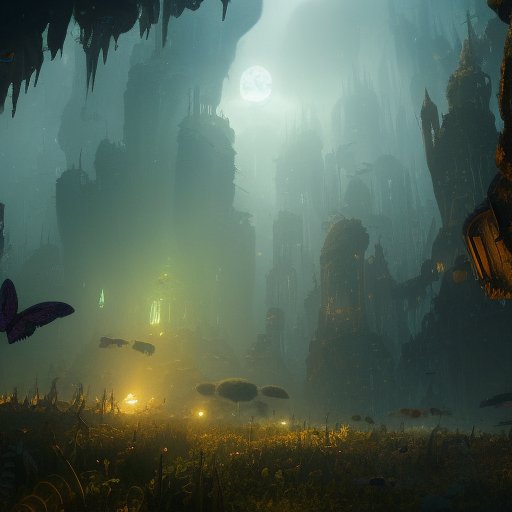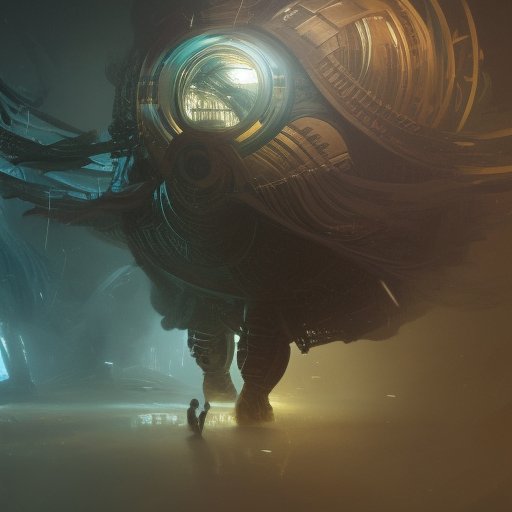
Set in an alternate Earth, this article delves into the biodiversity flourishing in a world that heavily relies on zeppelins for transportation. In the following pages, we explore the critical role held by zeppelins in maintaining various ecosystems’ health on this alternate earth. Scientists, researchers, and engineers alike rely on zeppelins to travel the world and study its complex and exotic creatures. However, we must also examine the potential threats to biodiversity from various sources such as pollution and climate change. With its unique ecosystems, this alternative Earth offers a promising new frontier for scientific research and discovery that is sure to leave readers yearning for more.
I. Introduction
Ladies and gentlemen, hold onto your hats, because we’re about to take a ride into the unknown. In this article, we’ll delve into an alternate earth, much like our own, but with a twist: it’s populated by zeppelins. Now, I know what you’re thinking: “Zeppelins? Aren’t those a bit outdated?” But before you write them off as a thing of the past, let me tell you: on this alternate earth, they’re not just a method of transport; they’re a way of life.

In this world, the skies are filled with mighty dirigibles, each one a unique and magnificent sight to behold. But what’s even more remarkable about this alternate earth is the extraordinary biodiversity that it supports. From lush forests teeming with exotic creatures to deep sea ecosystems that have never been seen by human eyes, this world is a wonderland of life.
But why is biodiversity so crucial, you ask? Well, my friends, the answer is simple: the more diverse an ecosystem is, the more resilient it is to change. On this alternate earth, the zeppelins play a crucial role in preserving this biodiversity, providing access to remote corners of the planet and enabling scientists and researchers to study and understand the unique ecosystems that call this world home.
But despite the zeppelins’ invaluable contribution to the world’s biodiversity, there are threats: from climate change to pollution and beyond, the natural world is more fragile than we might imagine. That’s why it’s more important now than ever before to understand the challenges we face on our own world, and to take action to protect and preserve the precious ecosystems that exist right here at home. So fasten your seat belts, ladies and gentlemen; we’re about to take a journey into a world that’s both familiar and entirely alien, a place where zeppelins roam the skies and exotic creatures lurk in the shadows. Get ready to be amazed!
II. The Alternate Earth
Welcome to the alternate earth, my friends. Here, the skies are ruled by zeppelins, those magnificent vessels that fill the air with the sound of their engines and the hum of their propellers. But it’s not just the zeppelins that make this world unique: it’s the biodiversity that flourishes in every corner of the planet.

Let’s start with the land. On this alternate earth, the forests are dense and vibrant, home to creatures unlike any we’ve ever seen. Brilliantly colored birds flit through the trees, while massive, lumbering beasts roam the forest floor. There are creatures with wings that shimmer like jewels, and creatures with scales that glint in the sunlight. Every inch of this world is teeming with life.
But it’s not just the land that’s alive: the seas are just as rich and varied. Picture an ocean teeming with creatures both bizarre and beautiful: glowing jellyfish, snakelike eels, and tentacled beasts that seem to defy imagination. In the deepest parts of the ocean, where light never reaches, there are creatures that are entirely unlike anything we’ve ever seen before: strange and wondrous beings that seem to belong to another world.
And then there’s the sky. Ah, the sky! Here, zeppelins rule the air, their massive gas bags and powerful engines carrying travelers and cargo alike across the vast expanse of this alternate earth. From the up high, one can see the entire planet, its forests and oceans stretching out as far as the eye can see.
It’s a breathtaking sight, folks, and it’s all thanks to the zeppelins that make it possible. But as we’ll see in the next section, there are dangers to this world, and we must be vigilant if we hope to protect the biodiversity that makes it so incredible.
III. The Importance of Biodiversity
My friends, biodiversity is the spice of life! Without it, the world would be a bland, boring place indeed. But what is biodiversity, you ask? Simply put, it’s the variety of life on Earth, from the tiniest microbe to the mightiest elephant.

But diversity isn’t just a matter of aesthetics; it’s an essential ingredient for the health of our planet. Think of it like a complex machine, with countless interconnected parts, each one playing a vital role in maintaining the whole. Without these parts, without biodiversity, the machine would break down, and life as we know it would come crashing to a halt.
On this alternate earth, the value of biodiversity is perhaps even more apparent than it is on our own. The varied ecosystems that exist here serve as a testament to the incredible resilience of life in the face of adversity, and are a source of awe and inspiration to all who witness them.
But preserving these ecosystems is no easy task. As I mentioned earlier, the world is a fragile place, and it’s all too easy for even the most well-meaning humans to inadvertently cause harm. That’s why it’s crucial that we take a proactive approach to conservation, working hard to protect and preserve the natural world that sustains us all.
And on this alternate earth, with its zeppelins and exotic creatures, that message is even more pressing. We owe it to ourselves and to future generations to ensure that the biodiversity of our world remains intact, that the complex and beautiful machine of life continues to spin forward into the future.
So let us remember the importance of biodiversity, not just on this alternate earth, but right here at home. Let us take action to protect and preserve this precious resource, so that we can continue to marvel at the wonders of the natural world for generations to come.
IV. The Role of Zeppelins in Maintaining Biodiversity
Zeppelins: they’re not just for sightseeing anymore. On this alternate earth, these magnificent airships play a critical role in preserving the planet’s biodiversity. How, you ask? Well, for starters, zeppelins offer an excellent vantage point for studying ecosystems from above, providing a bird’s eye view of the unique flora and fauna that inhabits this world.

But it’s not just the view from the top that makes zeppelins so invaluable. They’re also the go-to method of transportation for field researchers, allowing scientists to travel safely and efficiently to remote corners of this world that would otherwise be unreachable. From mountaintops to deep sea trenches, zeppelins enable us to explore every corner of this strange and wonderful world.
And let’s not forget the important role that zeppelins play in monitoring the health of various ecosystems. From air quality to water pollution, these airships carry sophisticated equipment that enables researchers to keep a constant eye on the state of the planet’s ecosystems. This kind of real-time data is crucial to understanding how the planet is changing and the threats that biodiversity faces.
But perhaps most importantly, zeppelins create an infrastructure that enables long-term research and observation. By providing a secure and reliable platform for research, these airships enable scientists to gather the data they need year-round, no matter the weather or other obstacles that might stand in their way.
V. Threats to Biodiversity
But my dear readers, all is not well with this alternate earth. Just as in our own world, there are forces threatening the delicate balance of life. Pollution, climate change, and over-harvesting of resources all pose a significant risk to the planet’s biodiversity.

The skies, once so clear and pristine, are now filled with smog and other pollutants. This pollution not only has a direct impact on the health of the planet’s creatures but also on the health of the zeppelins that are so crucial to the research being conducted on this world.
Climate change is another looming threat. As temperatures rise and weather patterns become more erratic, ecosystems are thrown out of balance, and many species face extinction. It’s a problem that we’re all too familiar with in our own world, but on this alternate earth, the stakes are even higher.
Finally, over-harvesting of resources poses a significant risk. In the quest to uncover the secrets of this alternative world, researchers and scientists risk damaging the very ecosystems they seek to understand.
So what can be done to mitigate these threats? The answer is not a simple one, but it begins with education and awareness. By understanding the ways in which our actions impact the planet’s biodiversity, we can take steps to minimize the damage. That might mean reducing our use of fossil fuels, enforcing stricter environmental regulations, or simply being mindful of our impact on the world around us.
Of course, there are also technological solutions that can be employed. From developing more efficient zeppelins that produce fewer emissions to researching new methods of sustainable energy generation, there’s a world of possibilities when it comes to preserving our planet’s biodiversity.
But perhaps the most important step we can take is simply to appreciate the sheer beauty and wonder of the world around us. By cultivating a deeper sense of connection to the natural world, we can begin to see our place in it more clearly and work towards a future that’s as bright and vibrant as the world we’re lucky enough to call home.
VI. Future Possibilities
We’ve talked about the value of biodiversity and the critical role zeppelins play in preserving it, but what lies ahead for this alternate earth? The possibilities are endless. With so much yet to be explored and understood, there’s no telling what kind of discoveries lie in store for the scientific, engineering, and artistic communities.

For instance, imagine the potential for new medicines and other groundbreaking technologies that could arise from studying the unique organisms that thrive in this alternate earth’s wildly different ecosystems. The possibilities extend beyond technology and into the realm of the imagination: what kind of art, music, and literature might be inspired by such a world? The possibilities are endless, limited only by our own imaginations.
But as we consider the future of this alternate earth, we must also consider the impact our actions will have on it. Just as biodiversity and the zeppelins are vital to the health of the planet, so too is responsible stewardship. We must take care not to exploit or destroy the precious resources that this world possesses.
Of course, there will always be those who seek to profit from the planet’s resources at any cost, as we’ve seen all too often in our own world. That’s why it’s essential that we establish ethical guidelines and regulations to protect the world’s biodiversity and ensure that the zeppelins continue to serve their vital role without causing harm.
VII. Conclusion
And so, dear readers, we come to the end of our journey. We’ve explored an alternate earth that’s populated by zeppelins and brimming with life, a world where ecosystems thrive and sustain each other in perfect harmony. It’s a world that’s not so different from our own, and yet it’s imbued with a sense of wonder that’s all its own.

Throughout this article, we’ve learned about the crucial importance of biodiversity, how it takes more than just human intervention to keep the natural world healthy and thriving. We’ve seen how zeppelins play a vital role in maintaining this delicate balance, providing a means for scientists and researchers to study ecosystems and learn how to better protect them.
But as we’ve noted before, the natural world is more fragile than we might think. It’s important now, more than ever, to take action to protect and preserve our planet and the unique ecosystems that exist right here at home. Whether it’s reducing our carbon footprint or supporting conservation efforts, there’s always something we can do to make a difference.
So let us take what we’ve learned from this alternate earth and apply it to our own world. Let us strive to protect and preserve the rich diversity of life that exists all around us, not just for ourselves, but for the generations that will come after us. And let us never forget the awe-inspiring wonder of the world we inhabit, a wonder that’s just waiting to be discovered and explored. Thank you for joining us on this journey into the unknown. Let’s continue to explore, to learn, and to protect the natural world that surrounds us.






